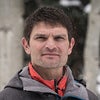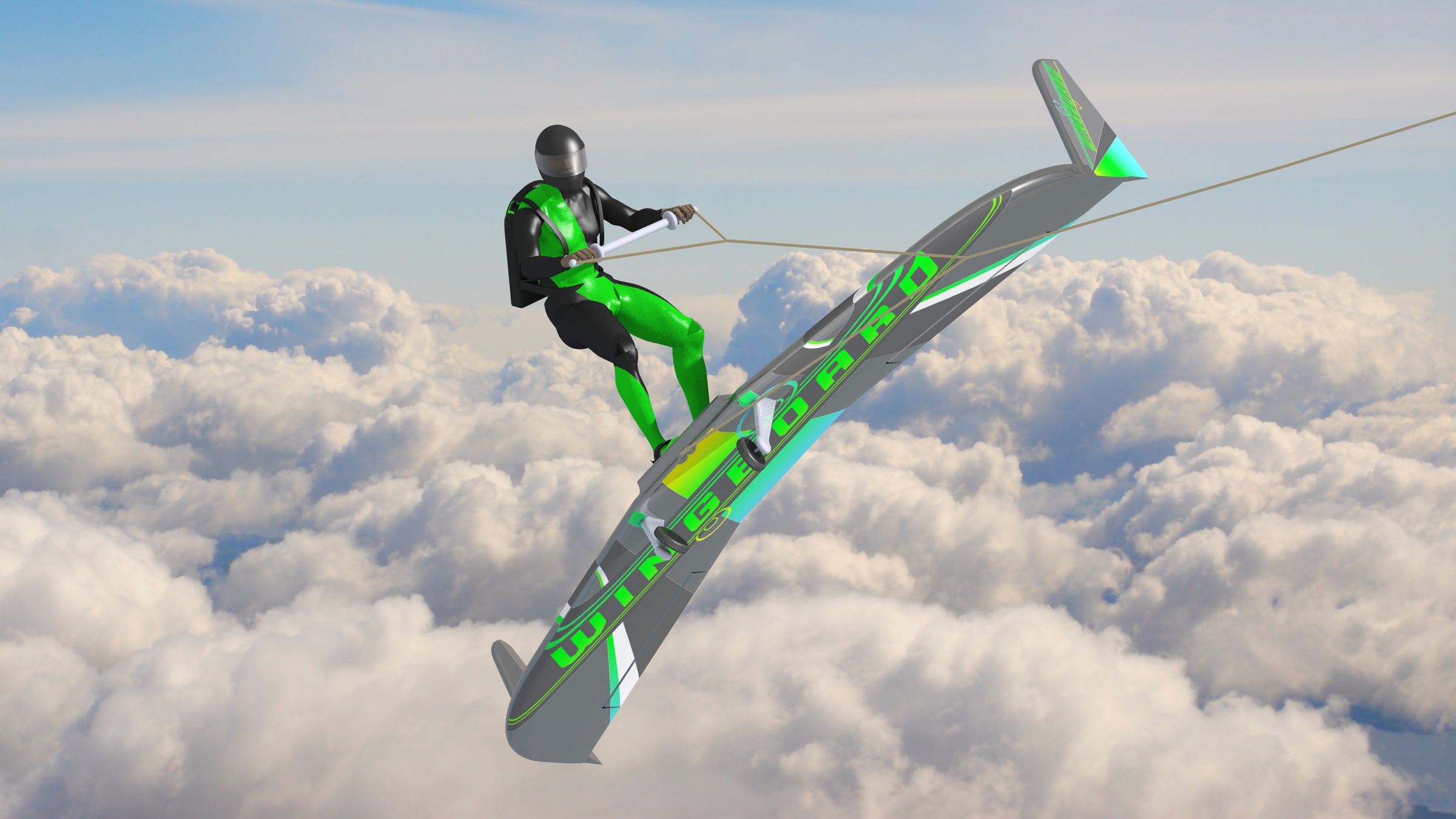When Aaron Wypyszynski was a kid, he used to get home from school, turn on the Disney animated cartoon “TaleSpin,” and watch episode after episode until his parents called him to dinner. In the cartoon, a furry brown bear named Kit Cloudkicker surfed the skies on a small wing while holding onto a tow rope attached to the rear of an airplane. The show only lasted a couple of seasons, and most of the world forgot about it—but not Wypyszynski.
Wypyszynski attended Purdue University, where he earned a master’s in aeronautical engineering. When he finished school six years ago, he took a job as a flight test engineer for a government contractor in Huntsville, Alabama. Now 31, Wypyszynski spends his days making sure new equipment on planes, and the vehicles themselves, perform the way they’re supposed to. It’s very practical work. But he never forgot about Kit Cloudkicker shredding the wild blue yonder—and as he gained expertise in aviation, he wondered if it might be possible to do the same thing in real life. “I always had that in the back of my mind,” Wypyszynski says.

One night in the spring of 2013, Wypyszynski got creative. “I just rolled up some pieces of paper and started playing around with them, and before I knew it, it was like, hey, this actually works,” he says. He observed that a wing could stay upright and glide through the air even with a heavier object (taped, in this case) on top of it. Paper airplanes aside, the concept seemed feasible. “There’s no reason why someone shouldn’t have done this already,” Wypyszynski says.
Done what, exactly? I ask.
“Taken wakeboarding to the sky.”
That is essentially what Wypyszynski is trying to do with the WingBoard (patent pending), a 12-foot-wide, 70-pound composite platform on which riders stand sideways and are locked in via bindings, like on a snowboard or wakeboard, while getting towed behind a plane at 110 mph, 2,000 feet off the ground. Riders will don goggles and a helmet, and perhaps a spandex or leather suit, to protect against the wind and cold.
Wypyszynski has spent more than $25,000 building and testing small-scale, remote-control prototypes, and he’s up to a model that is 40 percent the size of the hoped-for production model. It uses a 31-inch, 6.5-pound plastic rider that Wypyszynski and his cohorts call “James.” If the test flight ends with James and the board intact, and no unanticipated movements or oscillations, Wypyszynski deems it a success. It’s unclear exactly how much maneuverability a rider would have—James just stands there, strung along behind the plane. But the team recently executed a barrel roll with a remote control plane and James followed behind it, no problem.
“There’s no reason why someone shouldn’t have done this already.”
Wypyszynski says he wants to attach WingBoards to freestyle airshow planes and let riders do loops at up to 170 mph. Such forces won’t rip off their arms because the tow cord would attach to a body harness (instead of a rider’s hands), as well as to the board. In an emergency, riders would be able to eject and release their own parachute as well as the WingBoard’s. (If they couldn’t release the board’s chute, someone on the plane would be able to do it remotely.)
If this sounds a little like the old X Games “sport” skysurfing, it’s probably because that’s wingboarding’s closest relative. But while skysurfers simply plummet, wingboarders would plane, a far more attractive way to fly, Wypyszynski says. Since a short story aired on CNN earlier this month, Wypyszynski says he has been receiving “three emails a day from people wanting to be test pilots, and two a week from those very well qualified and internationally recognized.” The latter list includes wingsuit pilot Brandon Mikesell and Mike Swanson of the Red Bull Air Force.
“Right now we are at a major turning point in human flight,” Mikesell says. “Wingsuits are getting extremely efficient, and a lot of ‘firsts’ have already been accomplished in this aspect of flying. In my opinion, wingsuiting has hit a very pivotal point, and something needs to continue to push human flight to the next level. And the WingBoard is definitely it. Who wouldn’t want to carve around clouds like a real-life cloud surfer?”
Because the WingBoard will weigh less than 155 pounds, the FAA considers it an ultralight glider, Wypyszynski says. “They say, basically, as long as it’s under 155 and there’s only one person on it, we don’t care what you do with it.”
That applies to recreational use, anyway. Wyp Aviation, Wypyszynski’s nascent company, plans to sell new WingBoards for $10,000 and build between 25 and 100 per year, starting in 2017. If they find their way into drop zones and resorts for rental use, the FAA might have more to say about them, Wypyszynski says. His big-picture goal is to manufacture the boards and sell them to individuals and companies, while also promoting airshows and events where they would be featured.
Of the $270,000 Wypyszynski says he needs to complete his development, around $170,000 is for flight testing. He’s using a helicopter to get the WingBoard up to speed because it’s faster than a plane.
Will it all be worth it? Its creator thinks so.
“I’m 100 percent confident this will be viable and will work,” Wypyszynski says. “But the only way you can convince the nonbelievers is to go out and do it.”


